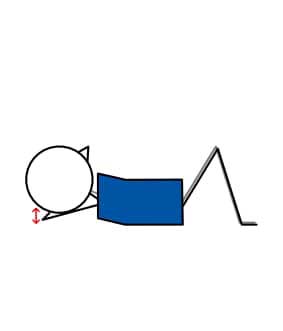Chest Lift FAQs
What level are the teaching directions?
Lie on back. Knees bent. Feet flat on floor. Hip, knee, and ankle are aligned. Toes are pointing directly away from you (natural curve of lower spine will create a slight lift off the mat). Shoulders down. Bring hands behind head with fingertips touching. Hands support base of skull. Slowly pull belly button down back toward spine. As you lengthen your spine, tilt chin slightly down. Keeping neck long, slowly lift upper spine off the mat, leading with the front of your chest. Neck and shoulders relaxed. When you reach the top of the move, inhale, drawing abdominals in deeper. Exhale as you slowly lower back to the mat. When lowering start with shoulders, keeping abdominals drawn in, then your neck. The back of your head should touch the mat last. Repeat.
What level are Chest Lift exercises for?
Beginners to advanced students.
Do Chest Lifts strengthen the core?
Yes.
Do Chest Lifts improve spine flexibility?
Yes.
What are some variations of the Chest Lift exercise?
Cervical Nod.
Crunches on a mini ball.
Relaxing Position.
Sit up rotations on a wobble board.
Sit-ups on a wobble board.
Can Chest Lifts improve my posture?
Yes. Chest lifts can improve your posture and keep your neck muscles strong.
What's the most common mistake when practising Chest Lifts?
When practising crunches, most inexperienced practitioners use the momentum they build up through the exercise. That's wrong. Chest lifts need to be performed slowly.
Should I engage my core on exhales?
Yes. Each time you exhale, make sure your core is fully engaged.
How can I stop jutting my chin out?
To maintain the proper form of your spine throughout the Chest Lift, imagine a tennis ball between your chest and chin. That's how much space you want to maintain throughout the movement. If your chin is jutting out (or too tucked in), it will add strain to your neck and back.
What props can I use for Chest Lifts?
You can use a rope, a strap, or a spine corrector to deepen the stretch.
What are the main precautions for Chest Lifts?
Final stages of pregnancy.
Have just delivered your baby.
Have a condition known as rectus diastasis.
Healing from surgery.
Healing from an abdominal injury.
Healing from a pelvis injury.
Have an abdominal hernia.
Have osteoporosis.
Have conditions affecting the bones of your spine.
Have sudden pain in your neck, shoulders, or chest when doing the move.

